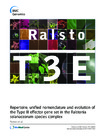Repertoire, unified nomenclature and evolution of the Type III effector gene set in the Ralstonia solanacearum species complex
dc.contributor.author
Peeters, Nemo
dc.contributor.author
Carrère, Sébastien
dc.contributor.author
Anisimova, Maria
dc.contributor.author
Plener, Laure
dc.contributor.author
Cazalé, Anne-Claire
dc.contributor.author
Genin, Stephane
dc.date.accessioned
2018-10-09T09:25:22Z
dc.date.available
2017-06-11T02:01:46Z
dc.date.available
2018-10-09T09:25:22Z
dc.date.issued
2013-12
dc.identifier.issn
1471-2164
dc.identifier.other
10.1186/1471-2164-14-859
en_US
dc.identifier.uri
http://hdl.handle.net/20.500.11850/76879
dc.identifier.doi
10.3929/ethz-b-000076879
dc.description.abstract
Background
Ralstonia solanacearum is a soil-borne beta-proteobacterium that causes bacterial wilt disease in many food crops and is a major problem for agriculture in intertropical regions. R. solanacearum is a heterogeneous species, both phenotypically and genetically, and is considered as a species complex. Pathogenicity of R. solanacearum relies on the Type III secretion system that injects Type III effector (T3E) proteins into plant cells. T3E collectively perturb host cell processes and modulate plant immunity to enable bacterial infection.
Results
We provide the catalogue of T3E in the R. solanacearum species complex, as well as candidates in newly sequenced strains. 94 T3E orthologous groups were defined on phylogenetic bases and ordered using a uniform nomenclature. This curated T3E catalog is available on a public website and a bioinformatic pipeline has been designed to rapidly predict T3E genes in newly sequenced strains. Systematical analyses were performed to detect lateral T3E gene transfer events and identify T3E genes under positive selection. Our analyses also pinpoint the RipF translocon proteins as major discriminating determinants among the phylogenetic lineages.
Conclusions
Establishment of T3E repertoires in strains representatives of the R. solanacearum biodiversity allowed determining a set of 22 T3E present in all the strains but provided no clues on host specificity determinants. The definition of a standardized nomenclature and the optimization of predictive tools will pave the way to understanding how variation of these repertoires is correlated to the diversification of this species complex and how they contribute to the different strain pathotypes.
en_US
dc.format
application/pdf
en_US
dc.language.iso
en
en_US
dc.publisher
BioMed Central
en_US
dc.rights.uri
http://creativecommons.org/licenses/by/2.0/
dc.subject
Type III effector
en_US
dc.subject
Ralstonia solanacearum
en_US
dc.subject
Selection
en_US
dc.subject
Horizontal gene transfer
en_US
dc.subject
Host specificity
en_US
dc.title
Repertoire, unified nomenclature and evolution of the Type III effector gene set in the Ralstonia solanacearum species complex
en_US
dc.type
Journal Article
dc.rights.license
Creative Commons Attribution 2.0 Generic
ethz.journal.title
BMC Genomics
ethz.journal.volume
14
en_US
ethz.journal.abbreviated
BMC Genomics
ethz.pages.start
859
en_US
ethz.size
18 p.
en_US
ethz.version.deposit
publishedVersion
en_US
ethz.identifier.wos
ethz.publication.place
London
en_US
ethz.publication.status
published
en_US
ethz.date.deposited
2017-06-11T02:02:37Z
ethz.source
ECIT
ethz.identifier.importid
imp5936515f1ecc924561
ethz.ecitpid
pub:121422
ethz.eth
yes
en_US
ethz.availability
Open access
en_US
ethz.rosetta.installDate
2017-07-17T07:36:51Z
ethz.rosetta.lastUpdated
2024-02-02T06:17:12Z
ethz.rosetta.versionExported
true
ethz.COinS
ctx_ver=Z39.88-2004&rft_val_fmt=info:ofi/fmt:kev:mtx:journal&rft.atitle=Repertoire,%20unified%20nomenclature%20and%20evolution%20of%20the%20Type%20III%20effector%20gene%20set%20in%20the%20Ralstonia%20solanacearum%20species%20complex&rft.jtitle=BMC%20Genomics&rft.date=2013-12&rft.volume=14&rft.spage=859&rft.issn=1471-2164&rft.au=Peeters,%20Nemo&Carr%C3%A8re,%20S%C3%A9bastien&Anisimova,%20Maria&Plener,%20Laure&Cazal%C3%A9,%20Anne-Claire&rft.genre=article&rft_id=info:doi/10.1186/1471-2164-14-859&
Files in this item
Publication type
-
Journal Article [128795]

